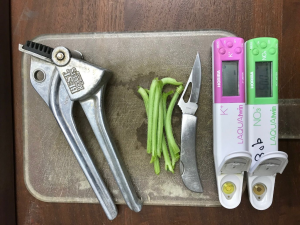UF/IFAS Extension agents are always looking for ways to help their growers be as environmentally and economically sustainable as possible. We achieve this goal by applying Best Management Practices (BMP) and supporting technologies as they become available. The purchase of BMP demonstration tools, including petiole sap testing meters for nitrate-nitrogen and potassium (LAQUA Meters), allowed Northeast District agents to work one-on-one with growers. We did this at their farming locations during various growing seasons to help fine tune their nutrient management practices. Eight agents in the Suwannee Valley used the testing meters in their approximately 10 county coverage area. Grant funding from the Florida Department of Agriculture and Consumer Services (FDACS) Office of Ag Water Policy covered the cost. You can perform petiole sap testing on a variety of crops. However, in the Suwannee Valley, we most commonly use it on crops like watermelon, tomato, pepper, cantaloupe, and strawberry.
Objective
Petiole sap testing meters help growers learn how to maintain BMP compliance regarding nutrient management. These meters allow the user to obtain an instant reading of plant sap nitrate-nitrogen and potassium concentrations. Giving growers the current nutrient status of their crop allows them to make better decisions regarding fertilization needs. This sap reading often prompts growers to lengthen the time between fertilizations. Minimizing nutrient inputs help with nitrogen reduction. It can also save growers quite a bit of money due to the high cost of fertilizer!

Sampling
During peak season, UF/IFAS Extension agents in the Suwannee Valley collect petiole sap samples across nearly 100 fields each week. These sites total approximately 5,000 acres! Needed supplies include sap testing meters for each nutrient of interest (LAQUA Meters) and accompanying calibration solution. You also need water, towels, cutting board, knife, garlic press for sap extraction, and finally the plant petioles.
To collect the petiole samples, one must locate the most recently matured leaf on the plant, remove this leaf from the plant, and repeat the task approximately 15-20 times throughout the field. The procedure involves removing the petioles from the leaf and cutting them into smaller pieces to fit into the garlic press. The next step is to calibrate the meters. Then you can test the petiole sap by squeezing the sap onto the meters and taking the measurement. After the results have been recorded, agents relay the numbers to the growers to help them make the best fertilization decisions for their growing crop.
Results
On-farm petiole sap testing is an ongoing effort by extension agents in the Suwannee Valley. The goal is to help growers increase the sustainability of their crop production through BMP implementation. Here are a few petiole sap testing project results:
- In 2014, seven local extension agents collected petiole sap samples in 11 counties from 43 farms during a 2-month period, resulting in 267 petiole sap samples. A one-on-one survey was conducted with cooperating growers to document changes in practices as a result of the on-farm visits and demonstrations with the sap testing equipment. On average, cooperating farmers reduced nitrogen and potassium rates by 10-20%!
- One watermelon farm, growing in Lafayette and Suwannee counties in the spring of 2022, tested petiole sap weekly during the growing season. This grower indicated each fertigation event cost $4200 on all his farmed acreage (approximately 500 acres). Sap testing results indicated the grower could reduce three fertigation events in one week in May. This resulted in a decrease in nitrogen fertilization of approximately 6,000 lbs. and an economic savings of $12,600!
- Most recently, in February 2024, extension agents from 7 counties within the Suwannee Valley reported there are approximately 8,000 acres of watermelon grown in the area each season. These agents surveyed growers who volunteered to be part of the UF/IFAS petiole sap testing service. As a result of this program, growers reported that petiole sap testing allowed them to reduce fertigation events by 1 week during the season, on average. They also had an average daily reduction of 1.75 lbs./acre/day during that week. Therefore, across the 5,640 acres of watermelons involved in this program in the Suwannee Valley, petiole sap testing efforts resulted in a seasonal reduction of approximately 69,090 total lbs. of both N and K2O!
This blog was written by Sydney Williams, Bob Hochmuth, Mark Warren, Tatiana Sanchez-Jones, Tyler Pittman, Emily Beach, Jay Capasso, and Dan Fenneman, UF/IFAS BMP Research and Extension Efforts .
 1
1

Comments:
April 22, 2024
Hi Ed. We have been getting our sensors and supplies from Spectrum Technologies (specmeters.com), but the Horiba Laqua Twin nitrate and potassium sensors are readily available online via many suppliers. As long as you find these particular meters online, let price and service be your guide.
April 9, 2024
Where can these meters be purchased for ones use. Nuturient testing in plant very interesting.